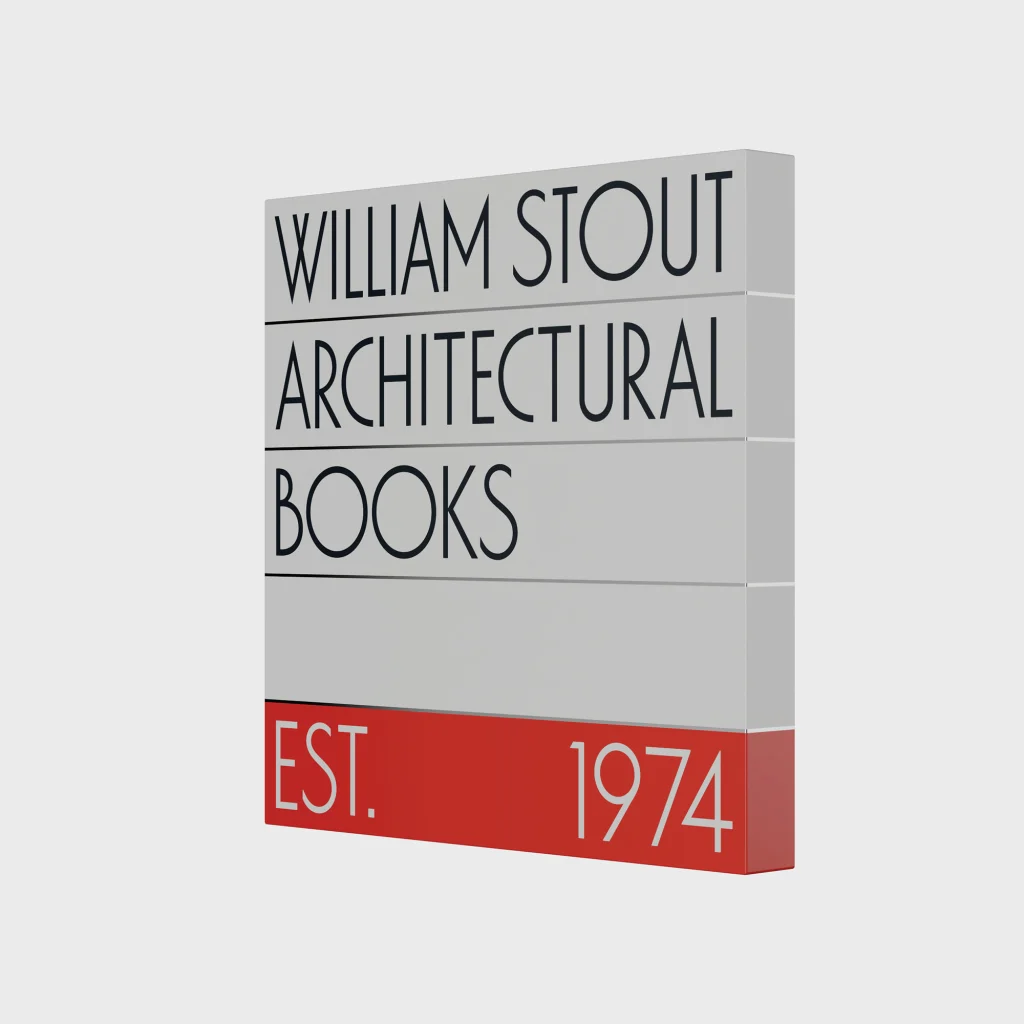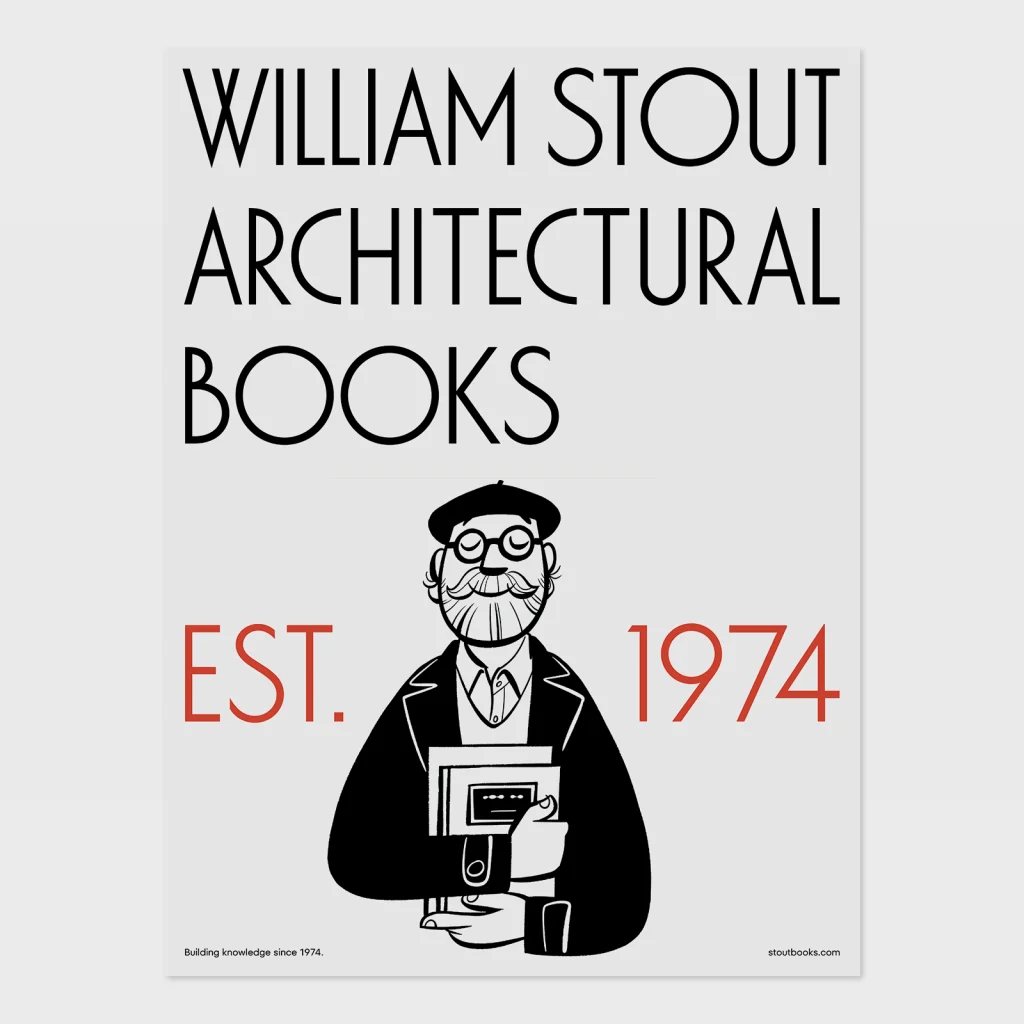See LoveFrom’s new branding for one of the best bookstores in the U.S.
Since 1974, William Stout Architectural Books in San Francisco’s Jackson Square has been one of the city’s most iconic destinations for its seemingly endless stock of art, design, and architecture books. As the store was approaching its 50th year in business with a fresh owner, the Eames Institute for Infinite Curiosity, it discovered a problem: It had run out of stickers to label its books. Then it discovered another problem—it didn’t have a formalized logo to print more.But as luck would have it, a fairly competent design firm resided just across the street that offered to help: LoveFrom.“It’s a store we loved. And if we didn’t get to design [their brand], it would have been like, ‘we wish we could have done that!” says Chris Wilson, designer at LoveFrom. “It’s something that falls into that category of projects we do for the love of doing them—quite organic by just being in the neighborhood and going in the store.”The ongoing health and legacy of San Francisco is a core reason that Jony Ive founded his studio in his favorite neighborhood, Jackson Square, which sits in the shadow of the Transamerica Pyramid. Ive first visited the neighborhood in 1989, and fell in love with William Stout, along with other local gems. When he left Apple to build LoveFrom, he did so here, right next door to Laurene Powell Jobs’s Emerson Collective, around the corner from his hardware startup with Sam Altman called io Products. After acquiring nearly $90 million in real estate, Ive is a landlord to several businesses in the neighborhood where he’s offered to lower rents, and LoveFrom has offered pro bono design services to many of its neighbors, like the local three Michelin star restaurant Quince, hoping that rising tides raise all boats. It all makes for a nice story. But the effect of this financial and creative investment on the ground level really has been something to watch. I’ve visited the neighborhood several times over the past few years, and have witnessed firsthand how the once sleepy blocks are now bustling with activity—like a successful game of SimCity playing out IRL.The William Stout bookstore is a preservation project unto itself, acquired by the Eames Institute in 2022, ensuring that the beloved destination will stick around into the foreseeable future. “We don’t want it to disappear,” says Lauren Smith, chief experience officer at the Eames Institute, who takes our call from deep in the William Stout stacks. “It’s important to the San Francisco design community and the neighborhood. There aren’t many architecture book stores left in the world.”[Image: LoveFrom]Rebuilding a brandWhen Wilson and fellow LoveFrom designer Antonio Cavedoni (who in a past life developed Apple’s San Francisco typeface) began searching for the store’s original logo, they learned William Stout never really had one; instead, the company’s small sign wrote out the store’s name in the typeface Washington upon a square placard, and that seemed to inform letterheads and other brand assets. It was a bit quirky and a bit architectural, but it didn’t feel codified into a larger, scalable brand system. “We kind of thought there was something to hold onto there,” says Wilson. “There’s a lot of stuff that was a bit odd and a bit weird. We loved some of that, but we just wanted to rationalize these things.”The team started by breaking down the core square into five equal quadrants. Then, they looked more closely at the typeface to fill them. Washington was a contemporary (albeit retro) typeface when the store opened. A mix of serif and sans serifs, some of its cleaner geometries (like a perfect circle O) made it appealing for a design store, but the Art Deco style—while spirited—felt too prescriptive of one particular era to represent the entirety of William Stout’s purview.[Image: LoveFrom]The obvious choice would have been to do what many do in this situation (and indeed, what William Stout had to do fill some of its brand needs throughout the years): opt for Futura, a now ubiquitous geometric typeface that has similar qualities to Washington. But instead, LoveFrom modified Washington into a new typeface it calls “LF Washington” with permission from Russell Bean, the creator of the typeface. Designers evened out the cap heights of Washington, while lowering the midlines that made for the high waisted Art Deco look. Meanwhile, LoveFrom drew new numbers that more closely align with the new letterforms.LF Washington sings on William Stout’s new sign. (The LoveFrom industrial design team created it custom out of enameled steel.) But it also looks straightforward as it balances atop photos to promote William Stout events. For times that the typeface needs to be more expressive, or playful, Cavedoni was inspired by another 1970s typeface’s—Avant Garde—approach to ligatures with its overlapping Os and letters nested inside other letters. Later, Cavedoni was joyed to discover that Frank Lloyd Wright took an all-around similar approach in his own bra

Since 1974, William Stout Architectural Books in San Francisco’s Jackson Square has been one of the city’s most iconic destinations for its seemingly endless stock of art, design, and architecture books. As the store was approaching its 50th year in business with a fresh owner, the Eames Institute for Infinite Curiosity, it discovered a problem: It had run out of stickers to label its books. Then it discovered another problem—it didn’t have a formalized logo to print more.
But as luck would have it, a fairly competent design firm resided just across the street that offered to help: LoveFrom.
“It’s a store we loved. And if we didn’t get to design [their brand], it would have been like, ‘we wish we could have done that!” says Chris Wilson, designer at LoveFrom. “It’s something that falls into that category of projects we do for the love of doing them—quite organic by just being in the neighborhood and going in the store.”
The ongoing health and legacy of San Francisco is a core reason that Jony Ive founded his studio in his favorite neighborhood, Jackson Square, which sits in the shadow of the Transamerica Pyramid. Ive first visited the neighborhood in 1989, and fell in love with William Stout, along with other local gems. When he left Apple to build LoveFrom, he did so here, right next door to Laurene Powell Jobs’s Emerson Collective, around the corner from his hardware startup with Sam Altman called io Products. After acquiring nearly $90 million in real estate, Ive is a landlord to several businesses in the neighborhood where he’s offered to lower rents, and LoveFrom has offered pro bono design services to many of its neighbors, like the local three Michelin star restaurant Quince, hoping that rising tides raise all boats.
It all makes for a nice story. But the effect of this financial and creative investment on the ground level really has been something to watch. I’ve visited the neighborhood several times over the past few years, and have witnessed firsthand how the once sleepy blocks are now bustling with activity—like a successful game of SimCity playing out IRL.
The William Stout bookstore is a preservation project unto itself, acquired by the Eames Institute in 2022, ensuring that the beloved destination will stick around into the foreseeable future. “We don’t want it to disappear,” says Lauren Smith, chief experience officer at the Eames Institute, who takes our call from deep in the William Stout stacks. “It’s important to the San Francisco design community and the neighborhood. There aren’t many architecture book stores left in the world.”
Rebuilding a brand
When Wilson and fellow LoveFrom designer Antonio Cavedoni (who in a past life developed Apple’s San Francisco typeface) began searching for the store’s original logo, they learned William Stout never really had one; instead, the company’s small sign wrote out the store’s name in the typeface Washington upon a square placard, and that seemed to inform letterheads and other brand assets. It was a bit quirky and a bit architectural, but it didn’t feel codified into a larger, scalable brand system.
“We kind of thought there was something to hold onto there,” says Wilson. “There’s a lot of stuff that was a bit odd and a bit weird. We loved some of that, but we just wanted to rationalize these things.”
The team started by breaking down the core square into five equal quadrants. Then, they looked more closely at the typeface to fill them.
Washington was a contemporary (albeit retro) typeface when the store opened. A mix of serif and sans serifs, some of its cleaner geometries (like a perfect circle O) made it appealing for a design store, but the Art Deco style—while spirited—felt too prescriptive of one particular era to represent the entirety of William Stout’s purview.
The obvious choice would have been to do what many do in this situation (and indeed, what William Stout had to do fill some of its brand needs throughout the years): opt for Futura, a now ubiquitous geometric typeface that has similar qualities to Washington. But instead, LoveFrom modified Washington into a new typeface it calls “LF Washington” with permission from Russell Bean, the creator of the typeface. Designers evened out the cap heights of Washington, while lowering the midlines that made for the high waisted Art Deco look. Meanwhile, LoveFrom drew new numbers that more closely align with the new letterforms.
LF Washington sings on William Stout’s new sign. (The LoveFrom industrial design team created it custom out of enameled steel.) But it also looks straightforward as it balances atop photos to promote William Stout events. For times that the typeface needs to be more expressive, or playful, Cavedoni was inspired by another 1970s typeface’s—Avant Garde—approach to ligatures with its overlapping Os and letters nested inside other letters. Later, Cavedoni was joyed to discover that Frank Lloyd Wright took an all-around similar approach in his own branding, making all these decisions feel pretty appropriate for an architectural bookstore.
The brand beyond the type
As the team considered the brand colors, it started with those on the original sign: black, white, and red. LoveFrom mostly stuck with this color system, but it expanded a palette of synergistic hues inspired by two of Le Corbusier’s famed color studies.
LoveFrom contracted illustrator Satoshi Hashimoto to create a series of illustrations. His vaguely mid-century cartoon style captures a kinetic energy that, as Wilson explains, juxtaposes the more formal architectural typography. “We wanted to soften [the type] with the warmth of what it feels like to walk in the store,” says Wilson. “There’s some jazz playing, the doors open, and you see the light inside the store.”
It’s yet another illustration of LoveFrom’s sense of whimsy offsetting its stricter approaches to geometry. These illustrations are perfect tote bag or T-shirt fodder, but they also introduce a subtle and sweet part of William Stout’s e-commerce UX.
Anyone visiting the newly launched William Stout website will be welcomed by an illustration of the shop’s storefront, drawn by Hashimoto. But what they might not realize until visiting again is that this storefront (and its solitary tree) changes with the seasons—yellow in the fall and adorned with multicolor lights in the winter. The front door is sometimes open and sometimes closed (matching the open/closed hours of the building). And if you look really closely, you will spot a bird somewhere in the scene—which was something of a mascot for Ray and Charles Eames. Click on it, and you’ll be ushered to the Eames Institute.
While not technologically complex, the evolving illustration a clever way to bridge a physical store with a digital shop that I’m a bit surprised I haven’t seen before.
“The website is definitely a way for us to get a bigger reach; we’re a very small square foot storefront in San Francisco,” says Smith. “But we want that shopping experience to feel like coming into the store.”
The new William Stout brand and website is live today.

































































































































































